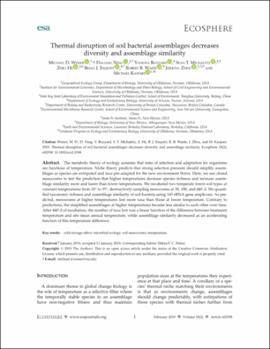| dc.contributor.author | Weiser, Michael D. | |
| dc.contributor.author | Ning, Daliang | |
| dc.contributor.author | Buzzard, Vanessa | |
| dc.contributor.author | Michaletz, Sean T. | |
| dc.contributor.author | He, Zhili | |
| dc.contributor.author | Enquist, Brian J. | |
| dc.contributor.author | Waide, Robert B. | |
| dc.contributor.author | Zhou, Jizhong | |
| dc.contributor.author | Kaspari, Michael | |
| dc.date.accessioned | 2019-02-14T16:12:45Z | |
| dc.date.available | 2019-02-14T16:12:45Z | |
| dc.date.issued | 2019 | |
| dc.identifier.citation | Weiser, M. D., D. Ning, V. Buzzard, S. T. Michaletz, Z. He, B. J. Enquist, R. B. Waide, J. Zhou, and M. Kaspari. 2019. Thermal disruption of soil bacterial assemblages decreases diversity and assemblage similarity. Ecosphere 10(2): e02598. 10.1002/ecs2.2598 | en_US |
| dc.identifier.uri | https://hdl.handle.net/11244/317549 | |
| dc.description.abstract | The metabolic theory of ecology assumes that rates of selection and adaptation for organisms are functions of temperature. Niche theory predicts that strong selection pressure should simplify assemblages as species are extirpated and taxa pre‐adapted for the new environment thrive. Here, we use closed mesocosms to test the prediction that higher temperatures decrease species richness and increase assemblage similarity more and faster than lower temperatures. We incubated two temperate forest soil types at constant temperatures from 10° to 35°, destructively sampling mesocosms at 30, 180, and 440 d. We quantified taxonomic richness and assemblage similarity of soil bacteria using 16S rRNA gene amplicons. As predicted, mesocosms at higher temperatures lost more taxa than those at lower temperature. Contrary to predictions, the simplified assemblages at higher temperatures became less similar to each other over time. After 440 d of incubation, the number of taxa lost was a linear function of the difference between treatment temperature and site mean annual temperature, while assemblage similarity decreased as an accelerating function of this temperature difference. | en_US |
| dc.description.sponsorship | This research was funded by a Macrosystems grant (NSF‐EF‐1065844) with James H. Brown as senior PI and the authors Michael Kaspari, Brian J. Enquist, Robert B. Waide, and Jizhong Zhou as co‐PIs as well as a NEON‐EAGER award (NSF‐EF‐1550731) to Michael Kaspari. Article processing charges funded in part by University of Oklahoma Libraries. | en_US |
| dc.language | en_US | en_US |
| dc.rights | CC BY 3.0 | * |
| dc.rights.uri | https://creativecommons.org/licenses/by/3.0/ | * |
| dc.subject | cold-storage effect | en_US |
| dc.subject | microbial ecology | en_US |
| dc.subject | soil mesocosms | en_US |
| dc.subject | temperature | en_US |
| dc.title | Thermal disruption of soil bacterial assemblages decreases diversity and assemblage similarity | en_US |
| dc.type | Article | en_US |
| dc.description.peerreview | Yes | en_US |
| dc.identifier.doi | 10.1002/ecs2.2598 | en_US |
| ou.group | College of Arts and Sciences::Department of Biology | en_US |

